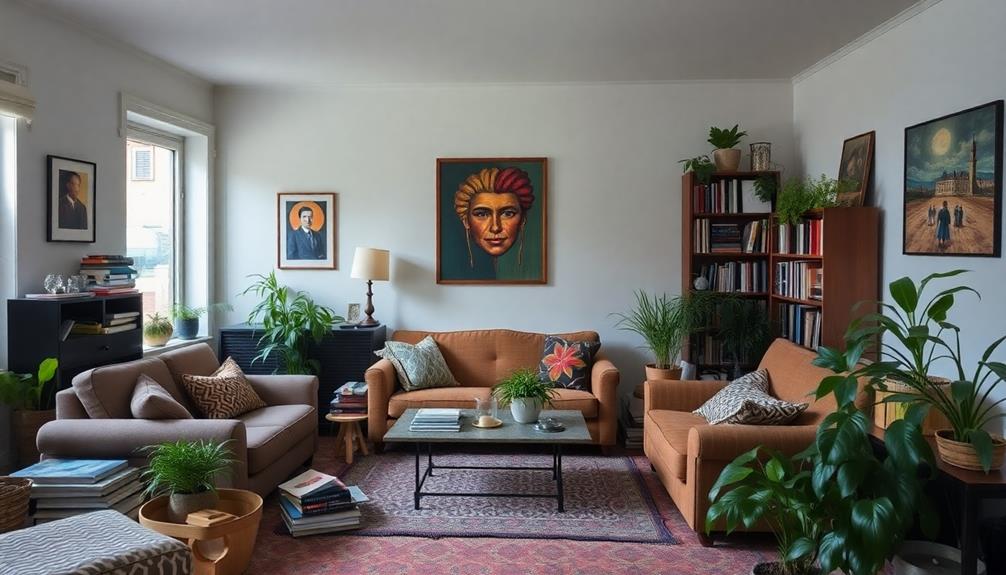Your interior decor might be suffering from common mistakes that ruin your space. Poor color choices can create a cramped, uninviting atmosphere. Overcrowded furniture leads to discomfort and chaos. Ignoring lighting results in a dreary vibe, while neglecting scale and proportion disrupts visual balance. Cluttered surfaces overwhelm your senses, and inadequate window treatments can block much-needed natural light. Moreover, a lack of focal points makes a room feel disjointed, and overlooking functionality hinders daily use. Don't worry—more insights await on how to transform your space beautifully and effectively!
Key Takeaways
- Poor color choices can create an uninviting atmosphere; aim for harmonious palettes that enhance the room's vibe.
- Overcrowded furniture makes spaces feel cramped; prioritize minimalist designs and multi-functional pieces for better functionality.
- Ignoring lighting diminishes a room's appeal; incorporate layered lighting to create a dynamic and inviting ambiance.
- Cluttered surfaces lead to visual chaos; regularly declutter and organize to maintain a clean and serene environment.
- Lack of focal points results in disjointed spaces; strategically place statement pieces to create visual interest and cohesion.
Poor Color Choices
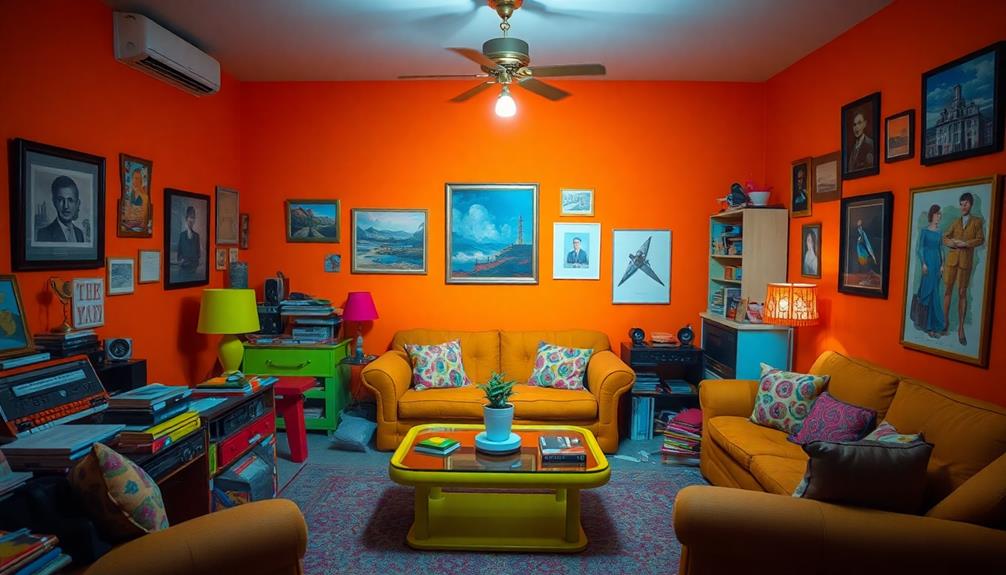
Color can make or break a room's vibe, and poor color choices often lead to a less-than-inviting atmosphere. You mightn't realize it, but the colors you choose can either enhance or hinder your space.
For instance, incorporating a coastal color palette can evoke a sense of calm and relaxation, aligning well with combining aesthetic and nautical room decor. Dark colors, for instance, can make a room feel smaller and more enclosed, while lighter shades open things up, creating a sense of airiness.
On the flip side, overly bright colors may cause visual fatigue, disrupting your mood and ambiance.
To achieve a cohesive look, focus on color harmony. A lack of harmony can make your space feel chaotic and disorganized.
Choose a neutral color palette for versatility, allowing you to mix and match different decor styles effortlessly. When incorporating accent walls, guarantee they complement the overall decor rather than create jarring contrasts.
This approach maintains visual flow and enhances the room's overall aesthetic appeal.
Overcrowded Furniture
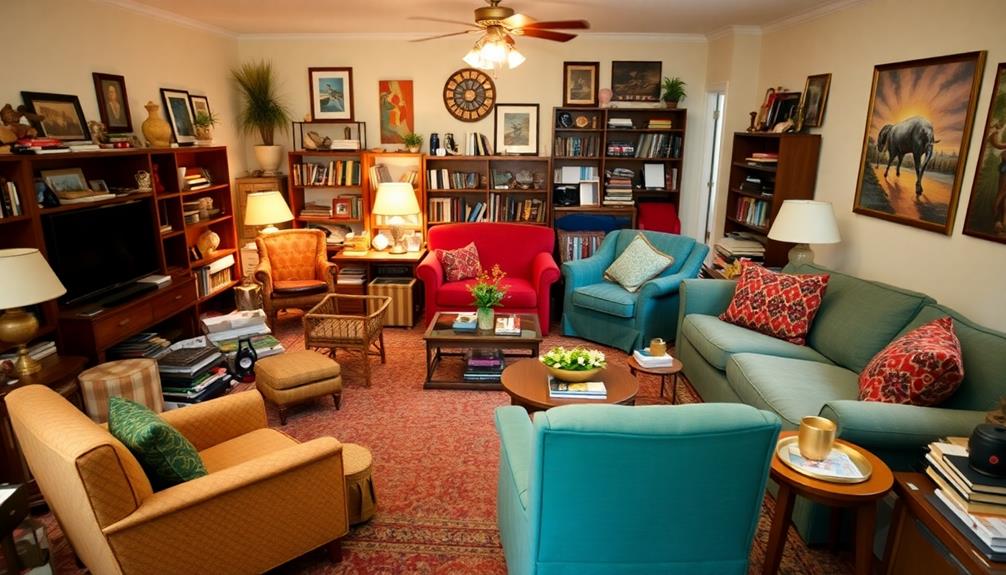
Overcrowding your space with furniture can quickly make a room feel cramped and uncomfortable. When large furniture pieces dominate smaller rooms, they create a visually chaotic environment that detracts from your overall decor.
You may find it difficult to move freely or enjoy the space when it's filled with overcrowded furniture. Adopting a minimalist approach, as seen in Scandinavian charm in kid-friendly homes, emphasizes functionality and creates a safe, clutter-free environment for relaxation and play.
Cluttered surfaces from excessive furniture can hinder relaxation and enjoyment, making it hard to unwind after a long day. Instead of feeling cozy, your room may feel more like a maze. Embracing minimalist designs can promote tranquility and allow for better utilization of the space you have.
Consider investing in multi-functional furniture, like ottomans with storage or convertible sofas, to maximize utility while reducing overcrowding. These pieces not only save space but can also enhance your decor by providing a clean, streamlined appearance.
Ignoring Lighting
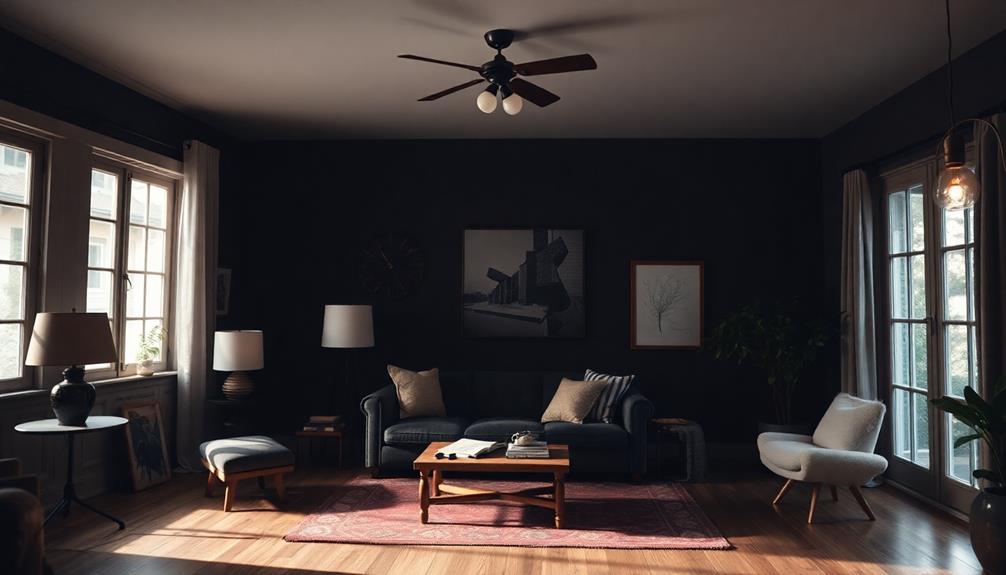
When it comes to interior decor, neglecting lighting can greatly diminish a room's appeal and functionality. Insufficient lighting can make your space feel uninviting and dreary, affecting your mood and how you use the area.
Instead, consider incorporating natural materials like wood and stone in your decor, which can work harmoniously with your lighting choices. Additionally, layering lighting is key; this includes ambient, task, and accent lighting. This combination not only enhances depth but also creates a dynamic atmosphere that can adapt to various activities.
Prioritizing natural light is another key factor. Positioning living areas near windows can considerably improve the ambiance and visual appeal of your space.
To add versatility, consider installing dimmers. They allow you to customize brightness levels, giving you the flexibility to set the right mood for different times of the day.
Additionally, don't underestimate the power of decorative lighting fixtures. They can serve as focal points, drawing attention and adding an artistic touch to your overall room design.
Neglecting Scale and Proportion

Lighting plays an essential role in creating a welcoming atmosphere, but it's just as important to contemplate the scale and proportion of your furniture and decor. Incorporating elements like Indonesian decorative pillows can add vibrant colors and patterns, enhancing the visual balance of your space.
Misjudging the size of your furniture can lead to visual imbalance, making your space feel cramped or awkwardly empty. To achieve proper scale, consider using the Golden Ratio (1:1.61) as a guideline, ensuring that your pieces fit harmoniously within the room.
Aim for your furniture to occupy no more than 60% of the space, allowing for flow and openness. Accent pieces should complement your main items, taking up about 40% of the room. If you have oversized decor, it can overwhelm smaller rooms, while tiny items may get lost in larger spaces, disrupting the intended aesthetic.
To avoid these pitfalls, create a blueprint or layout plan before shopping. This will help you visualize the right sizes for your furniture and decor, ensuring a cohesive and balanced design.
Cluttered Surfaces
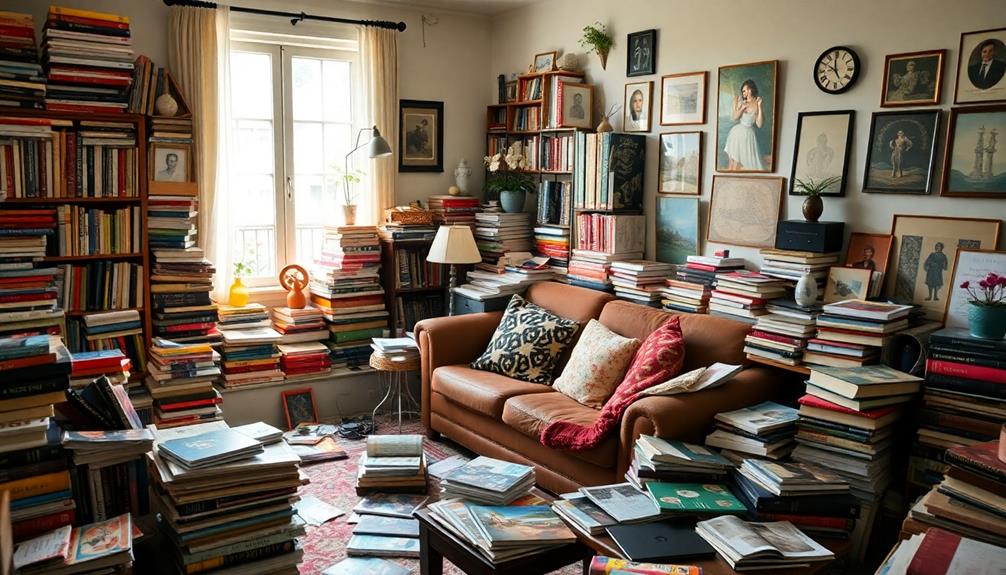
How can you create a serene and inviting atmosphere in your home? One of the most effective strategies is to address those cluttered surfaces. When surfaces are cluttered, they can lead to visual chaos, making your space feel overwhelming and disorganized.
This can negatively impact your mental clarity and relaxation. Incorporating aesthetic hooks and wall organization can also help in maintaining order while adding a touch of style to your decor.
To help maintain a fresh and inviting atmosphere, consider these tips:
- Regularly declutter: Make it a habit to clear off surfaces weekly.
- Prioritize functional items: Keep only what you use and love on display.
- Use trays: They can organize smaller items, making surfaces easier to manage.
- Implement storage solutions: Enclosed cabinets or baskets can hide away clutter.
- Create a designated space: Guarantee every item has its own spot to reduce mess.
Inadequate Window Treatments
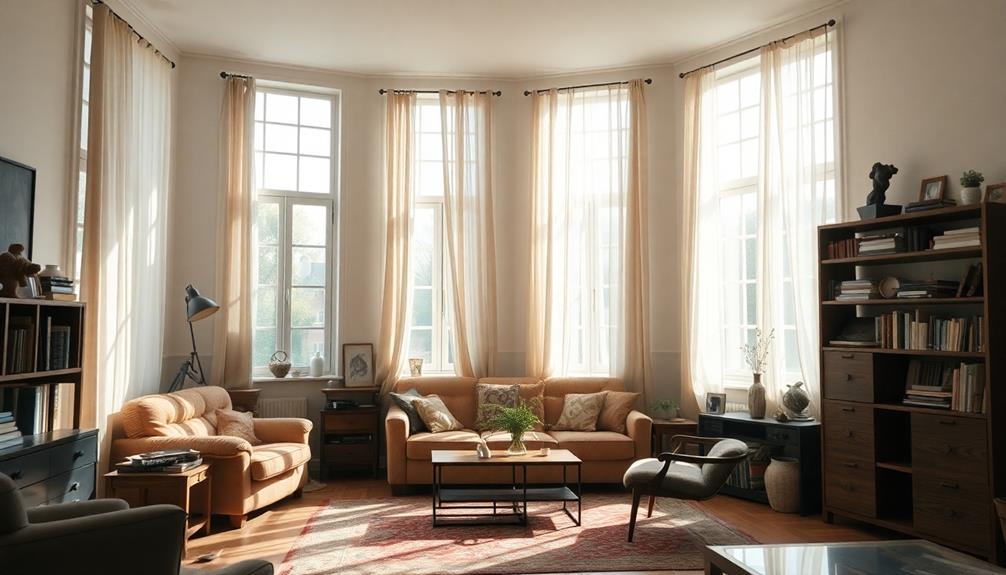
Inadequate window treatments can really impact how natural light flows into your space.
They play a vital role in achieving a harmonious balance between the indoor and outdoor environments, especially in designs that emphasize Balinese indoor-outdoor living.
If you choose fabrics that don't suit your room's style, it can make the whole area feel disjointed.
Enhance Natural Light
When you overlook the importance of window treatments, your space can quickly become dim and uninviting, impacting both mood and functionality. Inadequate window coverings can obstruct natural light, making your rooms feel darker.
To enhance the natural light in your home, consider these strategies:
- Opt for lighter fabrics: Heavy drapes block valuable sunlight. Sheer materials can help maximize natural light while maintaining privacy. The choice of materials can echo elements from traditional design, enriching your space with both functionality and style.
- Layer your treatments: Combining shades with sheer curtains not only allows for ideal light flow but also adds visual interest.
- Choose complementary colors: Select patterns and colors that enhance your room's decor, creating a cohesive look while maximizing light.
- Regularly reassess your choices: Updating your window treatments can maintain a fresh and airy atmosphere, preventing your space from feeling stale.
- Use adjustable options: Blinds or shades that you can easily open or close allow you to control the amount of natural light entering your space.
Choose Appropriate Fabrics
Choosing the right fabrics for your window treatments can make all the difference in how your space feels and functions. Inadequate window treatments, like bare windows, can leave your room feeling unfinished and uninviting.
When you place furniture against the walls, it can create an open atmosphere, but without proper window coverings, your room may still look stark and unbalanced. Incorporating elements from luxury tropical design aesthetics can also elevate the overall ambiance of your space, enhancing its appeal.
Avoid heavy drapes that block natural light, as they can make your space feel gloomy and even increase energy costs. Instead, consider layering window treatments. Combining sheer curtains with heavier drapes not only enhances privacy but also adds texture and depth, making your room more dynamic and visually appealing.
When selecting fabrics, pay attention to color and pattern. The right choices should complement your overall decor, helping to create a harmonious and balanced aesthetic.
Lack of Focal Points

A room without clear focal points can feel disjointed and chaotic, making it hard for your eyes to settle on any particular feature.
This lack of focal points detracts from the overall design cohesion and can leave your space feeling confusing. To enhance your interior decor, consider these strategies for incorporating effective focal points:
- Statement Art: A bold piece of artwork, such as an Indonesian decor mask, can serve as a fascinating focal point. These masks represent rich cultural heritage and can add vibrant colors to your space.
- Striking Furniture: Unique furniture, like an eye-catching chair or table, can draw attention and anchor the space.
- Strategic Placement: Position your focal point at the end of a room to create a natural line of sight.
- Balance Elements: Confirm that surrounding decor complements your focal points, preventing any single piece from overwhelming the space.
- Scale Consideration: In larger rooms, use multiple focal points while paying attention to scale and proportion to avoid visual clutter.
Overlooking Functionality
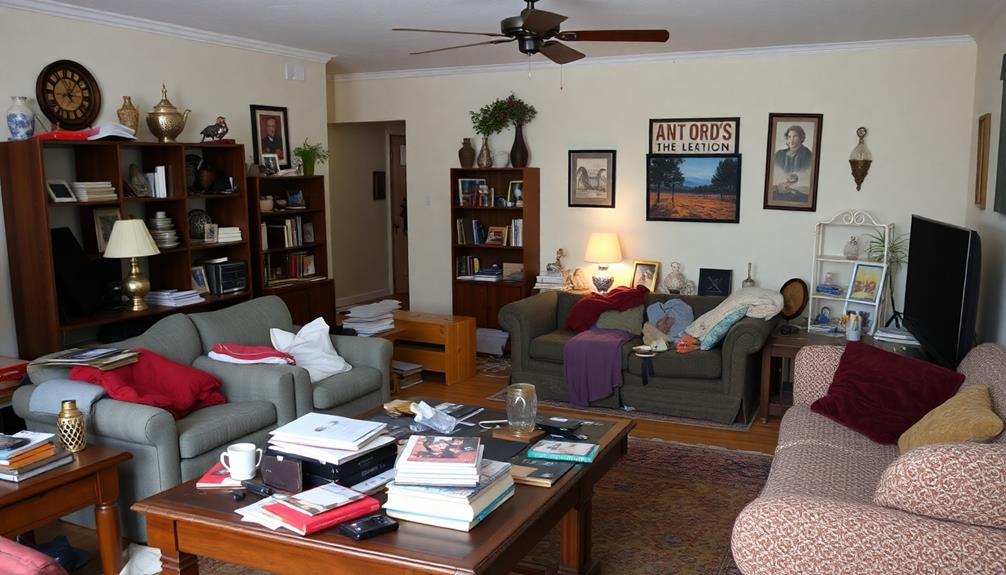
Functionality is the backbone of any well-designed space, ensuring that your home not only looks good but also serves your daily needs. When you overlook functionality in your decor, you risk creating a space that's more about aesthetics than usability.
In traditional Indonesian housing, for example, the design often incorporates practical elements that cater to the local environment and cultural practices, reflecting a deep understanding of traditional Indonesian housing.
Start by prioritizing areas that cater to your daily activities. For instance, consider combining a dining and workspace to maximize utility without sacrificing style.
Investing in ergonomic seating is essential too; comfort should never be an afterthought. It promotes well-being and enhances usability, making your space inviting and practical.
Don't forget about practical design elements like adequate storage solutions. Clutter can quickly ruin an otherwise beautiful room, so incorporating functional storage keeps your environment organized and improves overall functionality.
Ignoring Personal Style
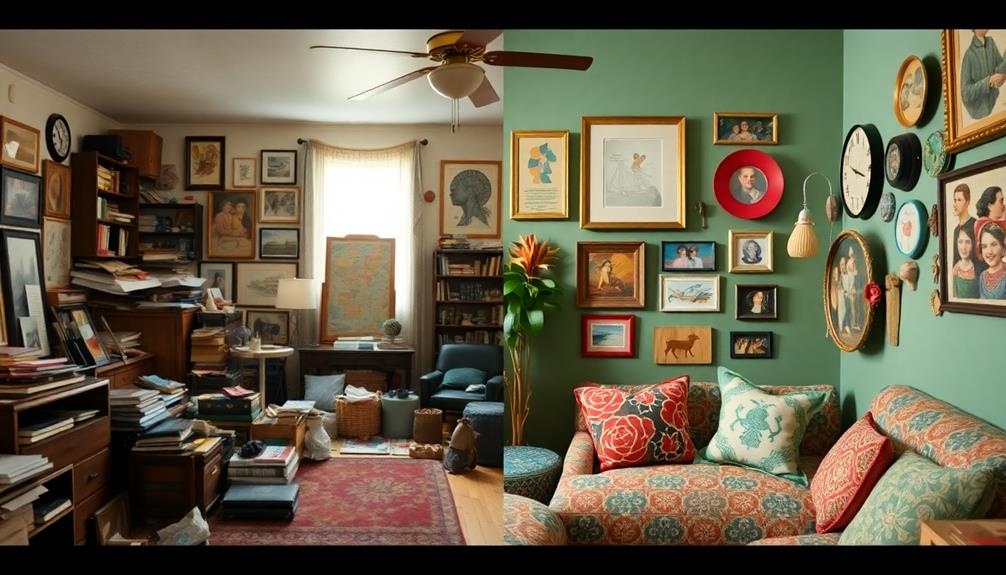
Ignoring your personal style can leave your space feeling cold and uninviting.
By adding unique touches that reflect your preferences, you transform generic decor into something meaningful.
Embracing what resonates with you not only enhances the room's character but also creates a sanctuary you truly love.
Emphasizing Individual Preferences
When you decorate your space without considering your personal style, it often ends up feeling generic and uninviting. To avoid this, it’s important to infuse your own personality and taste into your decor. Whether it’s through unique furniture choices, bold colors, or quirky accent pieces, your space should reflect who you are. There are plenty of small space decorating ideas out there to help you achieve a personalized and stylish look, from clever storage solutions to creative furniture arrangements. By considering your personal style and incorporating small space decorating ideas that suit your needs, you can create a space that is both inviting and unique to you.
One of the biggest interior design mistakes you can make is neglecting what truly resonates with you. A home that reflects your tastes fosters a deeper emotional connection, making it more enjoyable to live in.
Here are a few ways to emphasize your individual preferences:
- Showcase favorite artworks that inspire you daily.
- Incorporate family photos to create a sense of nostalgia and warmth.
- Select colors and patterns that you genuinely love, not just what's trending.
- Curate unique decor items from your travels or hobbies to tell your story.
- Invest in timeless pieces that reflect your style, ensuring longevity in your decor choices.
Adding Unique Touches
Personalizing your decor is a powerful way to create a unique atmosphere in your home, yet many people still fall into the trap of opting for generic styles. One of the biggest mistakes people make is overlooking the importance of personal touches, like family photos or unique art pieces.
These elements greatly enhance your space's warmth and character, making it more inviting. When you choose generic decor, your home can feel cold and unwelcoming. Instead, select items that reflect your interests and experiences.
Incorporating your favorite colors, textures, and styles fosters a deeper connection with your living space, evoking positive emotions and memories.
Another common mistake is giving in to fleeting trends. While it might seem trendy, these choices often lack authenticity and can leave you dissatisfied in the long run.
Customizing your decor not only enhances satisfaction but also allows for creative expression that's both functional and beautiful.
Avoiding Generic Decor
To create a space that truly feels like home, you need to embrace your personal style and steer clear of generic decor.
Generic pieces often lack emotional connection, leaving your space feeling cold and uninspired. Instead, fill your home with items that reflect who you are.
Here are some tips for avoiding generic decor:
- Showcase family photos to evoke warmth and familiarity.
- Incorporate unique artwork that resonates with your personality.
- Choose favorite colors and textures that enhance your comfort.
- Explore thrift stores and local artisans for one-of-a-kind furniture pieces.
- Skip fleeting trends in favor of timeless designs that suit your taste.
Frequently Asked Questions
What Is the Golden Rule in Interior Design?
The Golden Rule in interior design focuses on scale and proportion. You should guarantee your furniture complements the room's size, creating balance. Following the Golden Ratio helps achieve harmonious proportions for a cohesive aesthetic.
What Are the Do's and Don'ts of Interior Design?
Imagine walking into a space that feels just right. Prioritize natural light, avoid overcrowding, focus on scale, and embrace your personal style. Regularly declutter to keep it inviting, and don't let chaos take over!
What Are the Effect of Bad Interior Decoration?
Bad interior decoration affects your mood and comfort. Dark colors can make spaces feel cramped, while overcrowded furniture hinders movement. Poor lighting and clutter add stress, making your home feel unwelcoming and disconnected from your style.
Does Interior Design Affect Mental Health?
Your surroundings are like a canvas; they can either soothe your soul or stir chaos in your mind. Yes, interior design affects your mental health—clutter clouds clarity, while light and nature nurture your well-being.
Conclusion
So, you thought your space was perfect, huh? Ironically, those decor "trends" might just be turning your home into a chaotic mess. By avoiding these common mistakes, you can transform your space into a stylish sanctuary that truly reflects your personality. Remember, the goal isn't just to impress others but to create a comfortable haven for yourself. So, take a step back, reassess, and let your home be a reflection of you, not just a Pinterest board.
